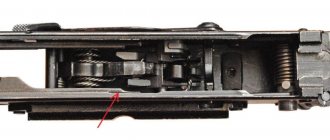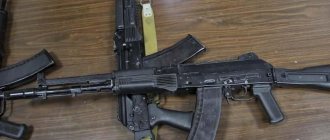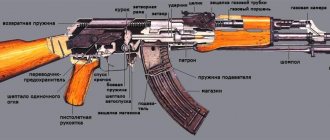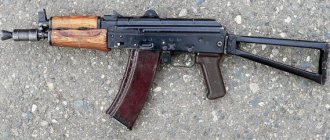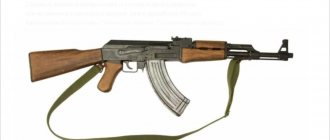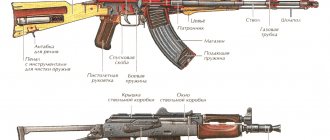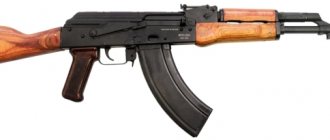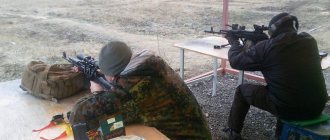For almost 70 years, the USSR and Russia have developed several dozen modifications, prototypes and concepts of the most popular small arms in the world - the Kalashnikov assault rifle. The universal base allows you to design “guns” for almost any taste: folding, shortened, with a bayonet, optics or an under-barrel grenade launcher, for special services or individual branches of the military.
In this material we will tell you how to learn to distinguish between the main AK models and what their unique features are.
AK-47
The classic, very first AK-47 adopted for service is difficult to confuse with anything else. Made of iron and wood, without any bells and whistles, it has long become a symbol of reliability and ease of use in any conditions. At the same time, it didn’t take long for the machine gun to become like this: it took Mikhail Kalashnikov several years to bring his creation to fruition.
In 1946, the military leadership of the USSR announced a competition to create an assault rifle chambered for an intermediate (in terms of destructive power - between a pistol and a rifle) cartridge. The new weapon had to be maneuverable, fast-firing, and have sufficient bullet lethality and shooting accuracy. The competition took place in several stages and was extended more than once, since none of the gunsmiths could give the required result. In particular, the commission sent AK-46 models No. 1, No. 2 and No. 3 (with a folding metal stock) for revision.
The improved Kalashnikov assault rifle, which was given the index AK-47, as Sergei Monetchikov writes in the book “The History of the Russian Automatic,” was almost completely redesigned. The best ideas were borrowed from the designs of competitors' weapons, implemented in individual parts and entire assemblies.
The machine gun did not have a classic solid stock. Taking into account the strong receiver, the separate wooden stock and fore-end contributed to holding the weapon during shooting. The design of the receiver was redesigned; it was fundamentally different from the previous ones with a special liner rigidly attached to it, connecting it to the barrel. In particular, a reflector of spent cartridges was attached to the insert.
The reloading handle, made integral with the bolt frame, was moved to the right side. This was demanded by test soldiers; they noted: the left-sided position of the handle interferes with shooting while moving on the move without stopping, touching the stomach. In the same position it is inconvenient to reload the weapon.
The transfer of controls to the right side of the receiver made it possible to create a successful fire switch (from single to automatic), which is also a fuse, made in the form of a single rotating part.
The large mass of the bolt frame and a powerful return spring ensured reliable operation of the mechanisms, including in adverse conditions: dusty, dirty, thickened lubricant. The weapon turned out to be adapted for trouble-free operation in the range of air temperature changes up to 100 degrees Celsius.
The wooden parts of the new weapon - the butt, fore-end and receiver grip, as well as the pistol grip, made from birch blanks - were coated with three layers of varnish, which ensured their sufficient resistance to swelling in damp conditions.
Automation operating principle
The automatic part of the AKS uses powder gases. After the shot they go under pressure into the gas chamber. There, sufficient pressure is generated to drive the gas piston, which is thrown back, simultaneously with the shutter system.
This unlocks the bore, the spent cartridge case is pushed out by moving the bolt and removed. The hammer is cocked due to the compression of the return spring produced by the bolt frame.
It, together with the shutter, returns to its original position - the return mechanism is triggered. At the same time, the next cartridge goes into a ready state, sliding into the chamber. This locks the barrel channel after the bolt protrusions go behind the stops and the bolt is turned to the right. The trigger is transferred to the cocked state after its self-timer is released by the self-timer sear.
AKS-47
Simultaneously with the AK-47, a model with the letter “C”, meaning “folding”, was also adopted. This version of the machine gun was intended for special forces and airborne forces; its difference was in the metal rather than wooden butt, which could also be folded under the receiver.
“Such a stock, which consisted of two stamped-welded rods, a shoulder rest and a locking mechanism, ensured ease of handling of the weapon - in the stowed position, when traveling on skis, parachuting, as well as its use for firing from tanks, armored personnel carriers, etc. .”, writes Sergei Monetchikov.
The machine gun was supposed to be fired with the butt folded down, but if this was not possible, the weapon could also be fired with the butt folded. True, it was not very comfortable: the butt rods had insufficient rigidity and strength, and the wide shoulder rest did not fit into the hollow of the shoulder and therefore tended to move from there when firing in bursts.
AKM and AKMS
The modernized Kalashnikov assault rifle (AKM) was put into service 10 years after the AK-47 - in 1959. It turned out to be lighter, longer-range and easier to use.
“We, and especially the main customer, were not satisfied with the accuracy when shooting from stable positions, lying down from a rest, standing from a rest. A solution was found by introducing a trigger retarder, which increased the inter-cycle time, Kalashnikov wrote in the book “Notes of a Weapon Designer.” “Later, a muzzle compensator was developed, which made it possible to improve the accuracy of combat during automatic shooting from unstable positions, standing, kneeling, lying down from the hand.”
The retarder allowed the bolt frame to stabilize in the extreme forward position before the next shot, which affected the accuracy of fire. The muzzle compensator in the form of a petal was installed on the barrel thread, and was one of the obvious distinctive features of the AKM. Due to the compensator, the trunk cut was not vertical, but diagonal. By the way, mufflers could be attached to the same thread.
Improving the accuracy of fire made it possible to increase its sighting range to 1000 meters, as a result, the aiming bar also changed, the range scale consisted of numbers from 1 to 10 (on the AK-47 - up to 8).
The butt was raised upward, which brought the resting point closer to the firing line. The external shape of the wooden forend has changed. On the sides it received rests for the fingers. The phosphate-varnish coating, which replaced the oxide coating, increased the anti-corrosion resistance tenfold. Monetchikov notes that the store, made not from steel sheets, but from light alloys, has also undergone radical changes. To increase reliability and protect against deformation, the side walls of its body were reinforced with stiffeners.
The design of the bayonet-knife, attached under the barrel, was also new. A sheath with a rubber tip for electrical insulation allowed the knife to be used for cutting through barbed wire and live wires. The combat power of the AKM increased significantly due to the possibility of installing the GP-25 Koster under-barrel grenade launcher. Like its predecessor, the AKM was also developed in a folding version with the letter “C” in the name.
How to distinguish Kalashnikov assault rifle models
In this material we will tell you how to learn to distinguish between the main AK models and what their unique features are.
AK (AK-47)
The classic, very first AK-47 adopted for service is difficult to confuse with anything else. Made of iron and wood, without any bells and whistles, it has long become a symbol of reliability and ease of use in any conditions. At the same time, it didn’t take long for the machine gun to become like this: it took Mikhail Kalashnikov several years to bring his creation to fruition.
In 1946, the military leadership of the USSR announced a competition to create an assault rifle chambered for an intermediate (in terms of destructive power - between a pistol and a rifle) cartridge. The new weapon had to be maneuverable, fast-firing, and have sufficient bullet lethality and shooting accuracy. The competition took place in several stages and was extended more than once, since none of the gunsmiths could give the required result. In particular, the commission sent AK-46 models No. 1, No. 2 and No. 3 (with a folding metal stock) for revision.
The improved Kalashnikov assault rifle, which was given the index AK-47, as Sergei Monetchikov writes in the book “The History of the Russian Automatic,” was almost completely redesigned. The best ideas were borrowed from the designs of competitors' weapons, implemented in individual parts and entire assemblies.
The machine gun did not have a classic solid stock. Taking into account the strong receiver, the separate wooden stock and fore-end contributed to holding the weapon during shooting. The design of the receiver was redesigned; it was fundamentally different from the previous ones with a special liner rigidly attached to it, connecting it to the barrel. In particular, a reflector of spent cartridges was attached to the insert.
The reloading handle, made integral with the bolt frame, was moved to the right side. This was demanded by test soldiers; they noted: the left-sided position of the handle interferes with shooting while moving on the move without stopping, touching the stomach. In the same position it is inconvenient to reload the weapon.
The transfer of controls to the right side of the receiver made it possible to create a successful fire switch (from single to automatic), which is also a fuse, made in the form of a single rotating part.
The large mass of the bolt frame and a powerful return spring ensured reliable operation of the mechanisms, including in adverse conditions: dusty, dirty, thickened lubricant. The weapon turned out to be adapted for trouble-free operation in the range of air temperature changes up to 100 degrees Celsius.
The wooden parts of the new weapon - the butt, fore-end and receiver grip, as well as the pistol grip, made from birch blanks - were coated with three layers of varnish, which ensured their sufficient resistance to swelling in damp conditions.
AKS (AKS-47)
Simultaneously with the AK-47, a model with the letter “C”, meaning “folding”, was also adopted. This version of the machine gun was intended for special forces and airborne forces; its difference was in the metal rather than wooden butt, which could also be folded under the receiver.
“Such a stock, which consisted of two stamped-welded rods, a shoulder rest and a locking mechanism, ensured ease of handling of the weapon - in the stowed position, when traveling on skis, parachuting, as well as its use for firing from tanks, armored personnel carriers, etc. .”, writes Sergei Monetchikov.
The machine gun was supposed to be fired with the butt folded down, but if this was not possible, the weapon could also be fired with the butt folded. True, it was not very comfortable: the butt rods had insufficient rigidity and strength, and the wide shoulder rest did not fit into the hollow of the shoulder and therefore tended to move from there when firing in bursts.
AKM and AKMS
The modernized Kalashnikov assault rifle (AKM) was put into service 10 years after the AK-47 - in 1959. It turned out to be lighter, longer-range and easier to use.
“We, and especially the main customer, were not satisfied with the accuracy when shooting from stable positions, lying down from a rest, standing from a rest. A solution was found by introducing a trigger retarder, which increased the inter-cycle time, Kalashnikov wrote in the book “Notes of a Weapon Designer.” “Later, a muzzle compensator was developed, which made it possible to improve the accuracy of combat during automatic shooting from unstable positions, standing, kneeling, lying down from the hand.”
The retarder allowed the bolt frame to stabilize in the extreme forward position before the next shot, which affected the accuracy of fire. The muzzle compensator in the form of a petal was installed on the barrel thread, and was one of the obvious distinctive features of the AKM. Due to the compensator, the trunk cut was not vertical, but diagonal. By the way, mufflers could be attached to the same thread.
Improving the accuracy of fire made it possible to increase its sighting range to 1000 meters, as a result, the aiming bar also changed, the range scale consisted of numbers from 1 to 10 (on the AK-47 - up to 8).
The butt was raised upward, which brought the resting point closer to the firing line. The external shape of the wooden forend has changed. On the sides it received rests for the fingers. The phosphate-varnish coating, which replaced the oxide coating, increased the anti-corrosion resistance tenfold. Monetchikov notes that the store, made not from steel sheets, but from light alloys, has also undergone radical changes. To increase reliability and protect against deformation, the side walls of its body were reinforced with stiffeners.
The design of the bayonet-knife, attached under the barrel, was also new. A sheath with a rubber tip for electrical insulation allowed the knife to be used for cutting through barbed wire and live wires. The combat power of the AKM increased significantly due to the possibility of installing the GP-25 Koster under-barrel grenade launcher. Like its predecessor, the AKM was also developed in a folding version with the letter “C” in the name.
AK-74
In the 1960s, the Soviet military leadership decided to develop small arms chambered for the low-impulse 5.45 mm caliber cartridge. The fact is that the AKM failed to achieve high accuracy of fire. The reason was that the cartridge was too powerful, which gave a strong impulse.
In addition, as Monetchikov writes, military trophies from South Vietnam also ended up in the hands of Soviet military specialists - American AR-15 rifles, the automatic version of which was later adopted by the US Army under the designation M-16. Even then, the AKM was inferior in many respects to the AR-15, in particular in terms of combat accuracy and hit probability.
“In terms of the difficulty of development, in terms of finding approaches, the construction of an assault rifle chambered for the 5.45-mm caliber can probably only be compared with the birth of the AK-47, the father of the entire family of our system. At first, when we decided to take the AKM automation scheme as a basis, one of the factory managers expressed the idea that there was no need to look for something and invent something here, they say, a simple re-barrel would be enough. “I marveled in my soul at the naivety of such a judgment,” Mikhail Kalashnikov recalled about that period. - Of course, changing a barrel of a larger caliber to a smaller one is not a difficult task. Then, by the way, the popular opinion began to circulate that we just changed the number “47” to “74”.
The main feature of the new machine gun was a two-chamber muzzle brake, which, when firing, absorbed approximately half of the recoil energy. A rail for night sights was mounted on the left side of the receiver. The new rubber-metal design of the butt butt with transverse grooves reduced its sliding along the shoulder when conducting aimed shooting.
The handguard and stock were initially made of wood, but switched to black plastic in the 1980s. The external feature of the butt was grooves on both sides; they were made to lighten the overall weight of the machine. Shops were also made from plastic.
AKS-74
For the Airborne Forces, a modification with a folding stock was traditionally made, although this time it was retracted to the left along the receiver. It is believed that this decision was not very successful: when folded, the machine gun was wide and rubbed the skin when worn behind the back. When worn on the chest, it became inconvenient if it was necessary to fold back the butt without removing the weapon.
A leather cheek muff appeared on the upper side of the butt; it protected the shooter’s cheek from freezing to a metal part in winter conditions.
AKS-74U
Following the world fashion of the 1960-70s, the USSR decided to develop a small-sized machine gun that could be used in cramped combat conditions, mainly when shooting at close and medium distances. The next announced competition among designers was won by Mikhail Kalashnikov.
Compared to the AKS-74, the barrel was shortened from 415 to 206.5 millimeters, which is why the gas chamber had to be moved back. This, writes Sergei Monetchikov, entailed a change in the design of the front sight. Its base was made in conjunction with the gas chamber. This design also caused the sight to be moved closer to the shooter’s eye, otherwise the aiming line would be very short. Finishing the topic of the sight, we note that the machine guns of this model were equipped with self-luminous attachments for shooting at night and in conditions of limited visibility.
The greater pressure of the powder gases required the installation of a reinforced flame arrester. It was a cylindrical chamber with a bell (an extension in the form of a funnel) at the front. The flame arrester was mounted on the muzzle of the barrel, on a threaded fit.
The shortened machine gun was equipped with a more massive wooden fore-end and a gas tube receiver; it could use either standard 30-round magazines or shortened 20-round magazines.
To more completely unify the shortened machine gun with the AKS-74, it was decided to use the same butt, which folds onto the left side of the receiver.
AK-74M
This machine gun is a deep modernization of the weapon adopted for service in 1974. Having retained all the best qualities inherent in Kalashnikov assault rifles, the AK-74M acquired a number of new ones that significantly improved its combat and operational characteristics.
The main feature of the new model was a folding plastic stock, replacing the metal one. It was lighter than its predecessors and similar in design to the permanent plastic stock of the AK-74 produced in the late 1980s. When worn, it clings less to clothing and does not cause discomfort when shooting in low or high temperature conditions.
The handguard and the barrel lining of the gas tube of the machine gun were made of glass-filled polyamide. In terms of heat transfer, the new material was almost no different from wood, which eliminated hand burns during prolonged shooting. Longitudinal ribs on the fore-end made it easier and more secure to hold the weapon during aimed fire.
"The hundredth series" (AK 101-109)
These modifications of the Kalashnikov, developed in the 1990s on the basis of the AK-74M, are called the first domestic family of commercial weapons, since they were intended more for export than for domestic consumption. In particular, they were designed for the NATO cartridge of 5.56 by 45 millimeters.
Wooden parts are completely excluded from the designs of the “100th” series assault rifles (similar to the best model of the 5.45 mm Kalashnikov assault rifle - AK74M). The butt and forearm of all are made of impact-resistant glass-filled polyamide in black color, for which this weapon, as Monetchikov writes, received the name “Black Kalashnikov” from the Americans. All models have plastic stocks that fold to the left along the receiver and a rail for mounting sights.
The most original in the “hundredth” series were the AK-102, AK-104 and AK-105 assault rifles. In their design, a breakthrough was made in increasing the level of unification between standard assault rifles and their shortened versions. Due to a slight increase in the overall length (by 100 millimeters compared to the AKS-74U), it became possible to leave the gas chamber in the same place as in the AK-74, thus allowing the use of a unified moving system and sighting devices on all machine guns of the series.
The “hundredth” series assault rifles differ from each other mainly in caliber, barrel length (314 - 415 millimeters), and sector sights designed for different ranges (from 500 to 1000 meters).
AK-9
This machine gun was also developed on the basis of the AK-74M; it also used developments from the “hundredth” series. Same black color, same polymer folding stock. The main difference from the classic Kalashnikovs can be considered a shortened barrel and a gas exhaust mechanism. Experts call the new pistol grip, which has better ergonomics, an important improvement.
The machine gun was created as a silent, flameless rifle system for covert shooting. It uses subsonic 9x39 mm cartridges, which together with a silencer make the shot almost inaudible. Magazine capacity - 20 rounds.
The forend has a special strip for various removable equipment - flashlights, laser pointers.
AK-12
The most modern assault rifle of the Kalashnikov family, testing of which has not yet been completed. One of the most striking external changes is the use of Picatinny rails for attaching attachments. Unlike the AK-9, they are both on the forend and on top of the receiver. At the same time, the lower bar does not interfere with the installation of under-barrel grenade launchers - this option is retained. The AK-12 also has two short rails on the sides of the handguard and one on top of the gas chamber.
In addition, the butt of the machine gun is easily removed and can be folded in both directions. On top of that, it is telescopic; the cheekpiece and butt plate are adjustable in height. There is also a variant of the machine gun with a stationary, lighter plastic butt.
The fire switch safety flag is duplicated on the left side; the machine gun can fire single, short series of three shots, and in automatic mode. And in general, all the controls of the machine gun are made in such a way that a soldier can use them with one hand, including changing the magazine and pulling the bolt. By the way, a variety of magazines can be used, up to an experimental drum with 95 rounds.
AK-74
In the 1960s, the Soviet military leadership decided to develop small arms chambered for the low-impulse 5.45 mm caliber cartridge. The fact is that the AKM failed to achieve high accuracy of fire. The reason was that the cartridge was too powerful, which gave a strong impulse.
In addition, as Monetchikov writes, military trophies from South Vietnam also ended up in the hands of Soviet military specialists - American AR-15 rifles, the automatic version of which was later adopted by the US Army under the designation M-16. Even then, the AKM was inferior in many respects to the AR-15, in particular in terms of combat accuracy and hit probability.
“In terms of the difficulty of development, in terms of finding approaches, the construction of an assault rifle chambered for the 5.45-mm caliber can probably only be compared with the birth of the AK-47, the father of the entire family of our system. At first, when we decided to take the AKM automation scheme as a basis, one of the factory managers expressed the idea that there was no need to look for something and invent something here, they say, a simple re-barrel would be enough. “I marveled in my soul at the naivety of such a judgment,” Mikhail Kalashnikov recalled about that period. - Of course, changing a barrel of a larger caliber to a smaller one is not a difficult task. Then, by the way, the popular opinion began to circulate that we just changed the number “47” to “74”.
The main feature of the new machine gun was a two-chamber muzzle brake, which, when firing, absorbed approximately half of the recoil energy. A rail for night sights was mounted on the left side of the receiver. The new rubber-metal design of the butt butt with transverse grooves reduced its sliding along the shoulder when conducting aimed shooting.
The handguard and stock were initially made of wood, but switched to black plastic in the 1980s. The external feature of the butt was grooves on both sides; they were made to lighten the overall weight of the machine. Shops were also made from plastic.
AKS-74
For the Airborne Forces, a modification with a folding stock was traditionally made, although this time it was retracted to the left along the receiver. It is believed that this decision was not very successful: when folded, the machine gun was wide and rubbed the skin when worn behind the back. When worn on the chest, it became inconvenient if it was necessary to fold back the butt without removing the weapon.
A leather cheek muff appeared on the upper side of the butt; it protected the shooter’s cheek from freezing to a metal part in winter conditions.
AKS-74U
Following the world fashion of the 1960-70s, the USSR decided to develop a small-sized machine gun that could be used in cramped combat conditions, mainly when shooting at close and medium distances. The next announced competition among designers was won by Mikhail Kalashnikov.
Compared to the AKS-74, the barrel was shortened from 415 to 206.5 millimeters, which is why the gas chamber had to be moved back. This, writes Sergei Monetchikov, entailed a change in the design of the front sight. Its base was made in conjunction with the gas chamber. This design also caused the sight to be moved closer to the shooter’s eye, otherwise the aiming line would be very short. Finishing the topic of the sight, we note that the machine guns of this model were equipped with self-luminous attachments for shooting at night and in conditions of limited visibility.
The greater pressure of the powder gases required the installation of a reinforced flame arrester. It was a cylindrical chamber with a bell (an extension in the form of a funnel) at the front. The flame arrester was mounted on the muzzle of the barrel, on a threaded fit.
The shortened machine gun was equipped with a more massive wooden fore-end and a gas tube receiver; it could use either standard 30-round magazines or shortened 20-round magazines.
To more completely unify the shortened machine gun with the AKS-74, it was decided to use the same butt, which folds onto the left side of the receiver.
Sighting device
Two parts: standard rotating rear sight with front sight.
The rear sight has 2 positions, depending on the firing range:
- "P" - at a distance of up to 350 m
- “5” - distance from 350 to a maximum of 500 m.
Additional device for shooting at night
The device is supplied separately. It is a self-luminous structure consisting of 2 parts:
- rear sight with extended folding slot
- front sight increased in width.
The rear sight does not replace the standard rotary one, but is mounted directly on it, like the front sight. Both components have markings that glow in the dark.
The device is installed on the machine once. To use the weapon during the day, it can simply be moved and locked.
AK-74M
This machine gun is a deep modernization of the weapon adopted for service in 1974. Having retained all the best qualities inherent in Kalashnikov assault rifles, the AK-74M acquired a number of new ones that significantly improved its combat and operational characteristics.
The main feature of the new model was a folding plastic stock, replacing the metal one. It was lighter than its predecessors and similar in design to the permanent plastic stock of the AK-74 produced in the late 1980s. When worn, it clings less to clothing and does not cause discomfort when shooting in low or high temperature conditions.
The handguard and the barrel lining of the gas tube of the machine gun were made of glass-filled polyamide. In terms of heat transfer, the new material was almost no different from wood, which eliminated hand burns during prolonged shooting. Longitudinal ribs on the fore-end made it easier and more secure to hold the weapon during aimed fire.
Operating countries
- USSR USSR - was originally developed as a weapon for the airborne troops, the first machine guns began to enter the troops in 1980, but later became widespread in marine units, as a reserve weapon for certain categories of ground forces (officers in the combat zone, signalmen , grenade launchers, armored vehicle crews, helicopter and airplane pilots), as well as special forces of the USSR Ministry of Internal Affairs and the USSR KGB.
- Belarus Belarus is in service with certain categories of military personnel, employees of the Ministry of Internal Affairs and the KGB
- Georgia Georgia
- Kazakhstan Kazakhstan is in service with certain categories of military personnel, employees of the Ministry of Internal Affairs and financial police.
- Kyrgyzstan Kyrgyzstan is in service with certain categories of military personnel, employees of the Ministry of Internal Affairs and customs service.
- Cuba Cuba is in service with the National Security Service.
- Latvia Latvia - despite receiving M16 assault rifles in 1997, was in service with the Suga reconnaissance and airborne battalion at least until mid-1999.
- Lithuania Lithuania - a number of AKS74U remains in service with the police and border guards.
- Mongolia Mongolia.
- Russia Russia: in service with certain categories of military personnel,
- in service with the Ministry of Internal Affairs of the Russian Federation, the FSSP of the Russian Federation, certain categories of employees of the Central Bank of the Russian Federation, PJSC Sberbank of Russia, FSUE Main Center for Special Communications
- in service with certain categories of military personnel of the armed forces of Ukraine,
- in service with police officers, state security services and the National Guard of the Ministry of Internal Affairs of Ukraine.
"The hundredth series" (AK 101-109)
These modifications of the Kalashnikov, developed in the 1990s on the basis of the AK-74M, are called the first domestic family of commercial weapons, since they were intended more for export than for domestic consumption. In particular, they were designed for the NATO cartridge of 5.56 by 45 millimeters.
AK-102
AK-107
Wooden parts are completely excluded from the designs of the “100th” series assault rifles (similar to the best model of the 5.45 mm Kalashnikov assault rifle - AK74M). The butt and forearm of all are made of impact-resistant glass-filled polyamide in black color, for which this weapon, as Monetchikov writes, received the name “Black Kalashnikov” from the Americans. All models have plastic stocks that fold to the left along the receiver and a rail for mounting sights.
The most original in the “hundredth” series were the AK-102, AK-104 and AK-105 assault rifles. In their design, a breakthrough was made in increasing the level of unification between standard assault rifles and their shortened versions. Due to a slight increase in the overall length (by 100 millimeters compared to the AKS-74U), it became possible to leave the gas chamber in the same place as in the AK-74, thus allowing the use of a unified moving system and sighting devices on all machine guns of the series.
The “hundredth” series assault rifles differ from each other mainly in caliber, barrel length (314 - 415 millimeters), and sector sights designed for different ranges (from 500 to 1000 meters).
Other options
In parallel with the shortening, submachine guns with similar performance characteristics are also used. The tactical and technical characteristics are not inferior to the model.
- Developed on the basis of the short Kalashnikov OTs-12 “Tiss” ( cartridges ) and OTs-14 “Groza”
- "Veresk" is a model with the same accuracy as a compact Kalashnikov assault rifle , but with a shorter firing distance. Less weight, more compact, plus the possibility of attaching a collimator sight.
For several decades, AKS weapon , the shortened, reliable Ksyukha, has been the most popular in the country and in the territories of the former Union.
OTs-14 "Thunderstorm"
AK-9
This machine gun was also developed on the basis of the AK-74M; it also used developments from the “hundredth” series. Same black color, same polymer folding stock. The main difference from the classic Kalashnikovs can be considered a shortened barrel and a gas exhaust mechanism. Experts call the new pistol grip, which has better ergonomics, an important improvement.
The machine gun was created as a silent, flameless rifle system for covert shooting. It uses subsonic 9x39 mm cartridges, which together with a silencer make the shot almost inaudible. Magazine capacity - 20 rounds.
The forend has a special strip for various removable equipment - flashlights, laser pointers.
AK-12
The most modern assault rifle of the Kalashnikov family, testing of which has not yet been completed. One of the most striking external changes is the use of Picatinny rails for attaching attachments. Unlike the AK-9, they are both on the forend and on top of the receiver. At the same time, the lower bar does not interfere with the installation of under-barrel grenade launchers - this option is retained. The AK-12 also has two short rails on the sides of the handguard and one on top of the gas chamber.
In addition, the butt of the machine gun is easily removed and can be folded in both directions. On top of that, it is telescopic; the cheekpiece and butt plate are adjustable in height. There is also a variant of the machine gun with a stationary, lighter plastic butt.
The fire switch safety flag is duplicated on the left side; the machine gun can fire single, short series of three shots, and in automatic mode. And in general, all the controls of the machine gun are made in such a way that a soldier can use them with one hand, including changing the magazine and pulling the bolt. By the way, a variety of magazines can be used, up to an experimental drum with 95 rounds

